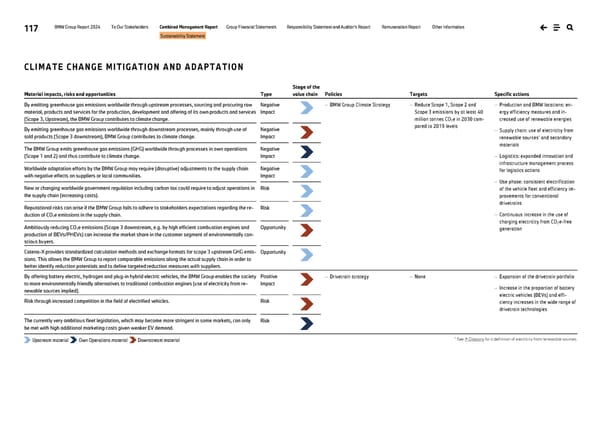117 BMW Group Report 2024 To Our Stakeholders Combined Management Report Group Financial Statements Responsibility Statement and Auditor’s Report Remuneration Report Other Information Sustainability Statement CLIMATE CHANGE MITIGATION AND ADAPTATION Material impacts, risks and opportunities Type Stage of the value chain Policies Targets Specific actions By emitting greenhouse gas emissions worldwide through upstream processes, sourcing and procuring raw material, products and services for the production, development and offering of its own products and services (Scope 3, Upstream), the BMW Group contributes to climate change. Negative Impact − BMW Group Climate Strategy − Reduce Scope 1, Scope 2 and Scope 3 emissions by at least 40 million tonnes CO2e in 2030 com- pared to 2019 levels − Production and BMW locations: en- ergy efficiency measures and in- creased use of renewable energies − Supply chain: use of electricity from renewable sources* and secondary materials − Logistics: expanded innovation and infrastructure management process for logistics actions − Use phase: consistent electrification of the vehicle fleet and efficiency im- provements for conventional drivetrains − Continuous increase in the use of charging electricity from CO2e-free generation By emitting greenhouse gas emissions worldwide through downstream processes, mainly through use of sold products (Scope 3 downstream), BMW Group contributes to climate change. Negative Impact The BMW Group emits greenhouse gas emissions (GHG) worldwide through processes in own operations (Scope 1 and 2) and thus contribute to climate change. Negative Impact Worldwide adaptation efforts by the BMW Group may require (disruptive) adjustments to the supply chain with negative effects on suppliers or local communities. Negative Impact New or changing worldwide government regulation including carbon tax could require to adjust operations in the supply chain (increasing costs). Risk Reputational risks can arise if the BMW Group fails to adhere to stakeholders expectations regarding the re- duction of CO2e emissions in the supply chain. Risk Ambitiously reducing CO2e emissions (Scope 3 downstream, e.g. by high efficient combustion engines and production of BEVs/PHEVs) can increase the market share in the customer segment of environmentally con- scious buyers. Opportunity Catena-X provides standardized calculation methods and exchange formats for scope 3 upstream GHG emis- sions. This allows the BMW Group to report comparable emissions along the actual supply chain in order to better identify reduction potentials and to define targeted reduction measures with suppliers. Opportunity By offering battery electric, hydrogen and plug-in hybrid electric vehicles, the BMW Group enables the society to more environmentally friendly alternatives to traditional combustion engines (use of electricity from re- newable sources implied). Positive Impact − Drivetrain strategy − None − Expansion of the drivetrain portfolio − Increase in the proportion of battery electric vehicles (BEVs) and effi- ciency increases in the wide range of drivetrain technologies Risk through increased competition in the field of electrified vehicles. Risk The currently very ambitious fleet legislation, which may become more stringent in some markets, can only be met with high additional marketing costs given weaker EV demand. Risk Upstream material Own Operations material Downstream material * See ↗ Glossary for a definition of electricity from renewable sources.
 BMW Group Report 2024 Page 116 Page 118
BMW Group Report 2024 Page 116 Page 118